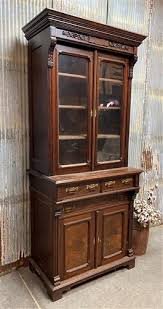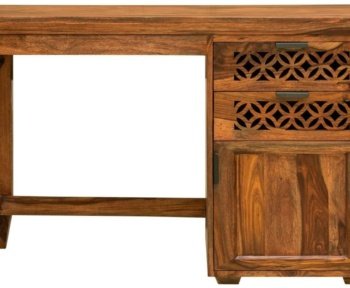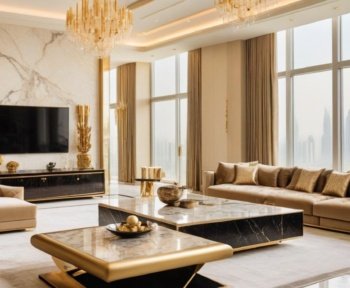Hutches have long been a staple in American homes, serving both functional and aesthetic purposes. Originally, they were designed as simple storage units for kitchenware, offering homeowners a convenient way to store dishes, glassware, and utensils. In the 18th and 19th centuries, hutches were primarily crafted from solid wood, often featuring intricate carvings and glass doors to display fine china. These early designs were heavily influenced by European craftsmanship, with ornate details and rich finishes that exuded sophistication. As these hutches became a common sight in American households, their purpose expanded beyond mere storage—they became a symbol of elegance and status.
By the mid-1800s, China cabinet and hutches had become larger and more elaborate, incorporating multiple shelves, drawers, and cabinets. They were often the centerpiece of dining rooms, where they showcased the homeowner’s best dishes and decorative pieces. Many families inherited hutches as heirlooms, passing them down through generations. These antique pieces remain highly sought after today, admired for their detailed woodwork and timeless appeal.
The Shift to More Functional Designs in the 20th Century
As the 20th century progressed, the design of hutches began to shift towards functionality. The early 1900s saw hutches becoming more practical, with simpler lines and fewer ornate details. The rise of industrial manufacturing made furniture more accessible, leading to the production of hutches in various sizes and styles to accommodate different household needs.
The mid-century modern movement of the 1950s and 1960s brought about a major transformation in furniture design, including hutches. The focus shifted to clean lines, minimalist aesthetics, and multifunctional use. Hutches were no longer exclusively found in dining rooms but were increasingly used in living rooms, offices, and even bedrooms. The emergence of new materials, such as plywood and laminate, allowed for more affordable options, making hutches a practical choice for the average American family.
During this time, hutches were also integrated into kitchen spaces as built-in units. This was particularly popular in suburban homes, where open floor plans encouraged seamless transitions between kitchen, dining, and living areas. The hutch evolved into a more streamlined storage solution, often incorporating sliding doors, adjustable shelves, and hidden compartments.
The Modern Evolution of Hutches in Contemporary Homes
In the 21st century, hutches continue to evolve, adapting to modern home design trends. While traditional wooden hutches remain popular, contemporary designs now incorporate metal, glass, and even recycled materials to appeal to eco-conscious consumers. The rise of modular and customizable furniture has also influenced hutch design, allowing homeowners to choose configurations that best suit their storage and display needs.
Today’s hutches are often designed with multipurpose functionality in mind. Many models include built-in lighting to highlight decorative pieces, while others offer charging stations for electronic devices. Open shelving has become a popular choice, allowing homeowners to create personalized displays with books, artwork, and plants. Additionally, the resurgence of farmhouse and rustic styles has brought back the charm of vintage-inspired hutches, complete with distressed finishes and reclaimed wood construction.
One of the most notable trends in recent years is the repurposing of antique hutches for modern use. Many homeowners seek out vintage hutches and refurbish them to fit contemporary spaces. This movement towards sustainability has given new life to older pieces, proving that well-crafted furniture can stand the test of time.
China Cabinet and Hutches prices in United States
FAQs About Hutches in American Homes
1. What is the main purpose of a hutch? A hutch serves as a storage and display unit, traditionally used in dining rooms to store china, glassware, and decorative items. However, modern hutches are also used in living rooms, kitchens, and offices for a variety of storage needs.
2. How do I choose the right hutch for my home? Consider your space, storage needs, and existing decor. If you have a traditional home, a solid wood hutch with ornate details might be a good fit. For modern spaces, a sleek, minimalist design with glass or metal elements could work well.
3. Are antique hutches valuable? Yes, antique hutches can be quite valuable, especially if they are made from high-quality wood and feature intricate craftsmanship. The value depends on factors such as age, condition, and brand.
4. Can I repurpose an old hutch for a different use? Absolutely! Many homeowners repurpose hutches as coffee bars, bookshelves, or entertainment centers. With a fresh coat of paint and some creative modifications, an old hutch can serve a completely new function in your home.
5. What materials are commonly used in modern hutches? Modern hutches are made from a variety of materials, including solid wood, engineered wood, metal, and glass. Many contemporary designs also incorporate eco-friendly and recycled materials.
Conclusion
The evolution of hutches in American homes reflects changing design trends, lifestyle needs, and advancements in furniture-making. From their origins as elegant dining room centerpieces to their modern-day role as versatile storage solutions, hutches have remained a beloved and practical addition to many households. Whether you’re looking for a traditional heirloom piece or a contemporary unit, there’s a hutch style to suit every home.
For those seeking high-quality hutches at the best prices, Crafters and Weavers offers a wide range of options that combine craftsmanship, durability, and timeless design. Investing in a well-made hutch not only enhances your home’s aesthetic but also provides functional storage that will last for generations.




